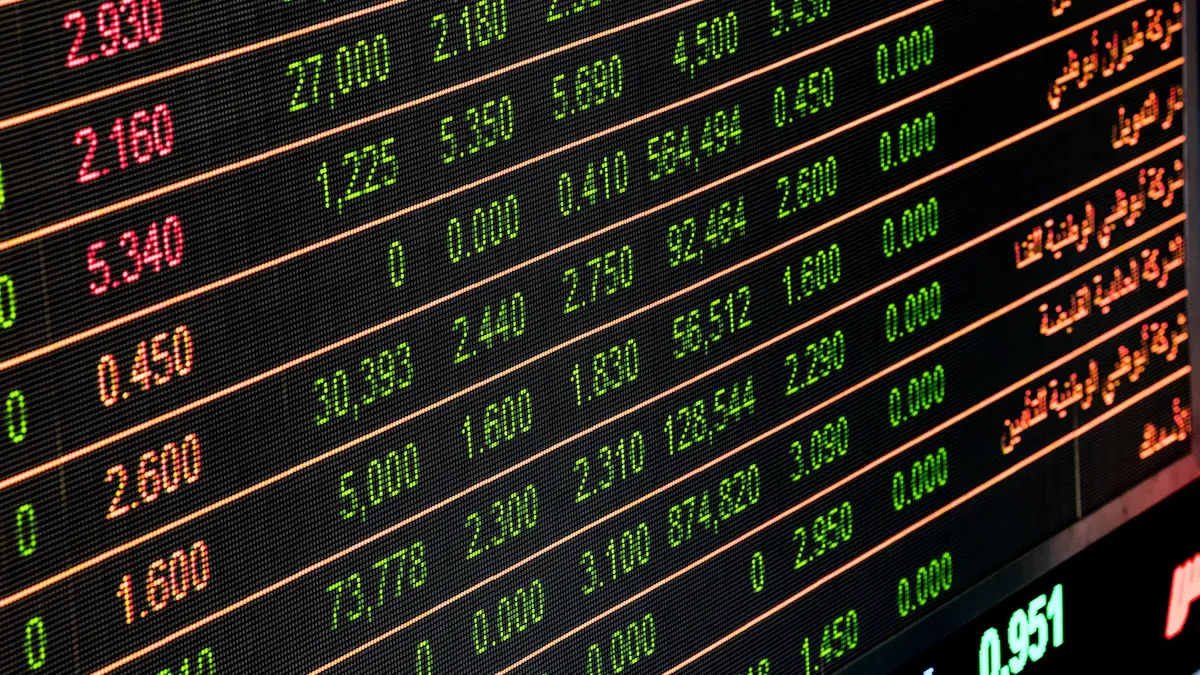- EasyCard
- Trade
- Help
- Announcement
- Academy
- SWIFT Code
- Iban Number
- Referral
- Customer Service
- Blog
- Creator
Introduction to Hong Kong Stock Trading: Basic Rules and Operational Steps

Image Source: unsplash
Hong Kong stock trading is a market full of opportunities, but to enter this market, you need to first understand the basic rules and operational steps. This knowledge can help you make more informed investment decisions and reduce risks. If you have questions like “how to buy Hong Kong stocks,” mastering the correct trading process is the most important step. Through learning, you can build confidence step by step and embark on your Hong Kong stock investment journey.
Key Points
- Understanding the trading hours of Hong Kong stocks can help you better plan your trades and avoid missing opportunities.
- Familiarizing yourself with the T+0 trading system and T+2 settlement rules can improve capital liquidity and reduce risks.
- Mastering minimum trading units and price movement rules can help you manage funds and trading costs more effectively.
- Choosing the right broker and trading platform can enhance the trading experience and reduce transaction fees.
- Regularly reviewing your investment portfolio and adjusting strategies in a timely manner can help you maintain stable returns amid market volatility.
Basic Rules of Hong Kong Stock Trading

Image Source: pexels
Trading Hours
The trading hours of the Hong Kong stock market are divided into three main sessions, each with distinct functions and characteristics. Below is the detailed time breakdown:
| Trading Session | Time |
|---|---|
| Pre-Opening Session | 9:00 AM to 9:30 AM |
| Continuous Trading Session | 9:30 AM to 12:00 PM (Morning Session) and 1:00 PM to 4:00 PM (Afternoon Session) |
| Closing Auction Session | 4:00 PM to 4:10 PM |
During the pre-opening session, investors can submit buy and sell orders, but trades are not executed immediately. The continuous trading session is the most active period, with all trades completed during this time. The closing auction session is used to determine the closing price. Familiarizing yourself with these sessions helps you better organize your trading plan and avoid missing important market opportunities.
T+0 Trading System and T+2 Settlement Rules
The Hong Kong stock market adopts a T+0 trading system, which means you can buy and sell the same stock multiple times within the same day, offering high flexibility. However, the settlement follows a T+2 model, meaning funds and stocks are settled on the second business day after the trade.
This system design helps enhance market liquidity while reducing settlement risks. For beginners, understanding this is crucial, as it directly affects your capital flow and investment strategy. For example, if you trade on a Friday, settlement will be completed on the following Tuesday. Therefore, you need to consider this time gap when planning your fund usage.
No Price Limit and Volatility Control Mechanism
The Hong Kong stock market has no price limit, allowing stock prices to fluctuate significantly within a single day. This feature provides investors with more profit opportunities but also increases risks. To balance market stability, the Hong Kong Stock Exchange implements a volatility control mechanism for 81 major constituent stocks of the Hang Seng Index and Hang Seng China Enterprises Index.
When a stock price fluctuates by more than 10% within 5 minutes, a 5-minute cooling-off period is triggered. During this period, trading is restricted to a ±10% range of the reference price. This mechanism effectively prevents panic selling or irrational buying due to excessive market volatility.
Additionally, research shows that herd behavior significantly increases market volatility, potentially leading to price bubbles or panic selling. Non-herd behavior, however, can stabilize the market during extreme sentiment, reducing further price declines. These rules and mechanisms provide investors with a safer trading environment.
Minimum Trading Unit and Price Movement Rules
In the Hong Kong stock market, each stock has a minimum trading unit, which is an important rule you need to understand when trading. The minimum trading unit refers to the smallest number of shares you must buy or sell in a single transaction. For example, some stocks have a minimum trading unit of 100 shares, meaning you cannot buy 50 or 75 shares; you must purchase at least 100 shares or multiples thereof (e.g., 200, 300 shares).
How to Check the Minimum Trading Unit?
You can check a stock’s minimum trading unit through the following methods:
- Hong Kong Stock Exchange Website: Visit the official Hong Kong Stock Exchange website, search for the stock code, and view its minimum trading unit.
- Trading Platform: Most trading platforms display the minimum trading unit on the order placement interface for quick reference.
- Broker Customer Service: If you’re unsure about a stock’s minimum trading unit, you can contact your broker’s customer service for clarification.
Tip: When selecting stocks, ensure you have sufficient funds to purchase the minimum trading unit to avoid being unable to complete a trade due to insufficient capital.
Price Movement Rules
The price movement rules in the Hong Kong stock market are based on the “minimum price movement unit.” This means that each stock price change must adhere to a specific increment. For example, for stocks priced between 0.25 USD and 0.50 USD, the minimum price movement unit is 0.001 USD; for stocks priced above 10 USD, the minimum price movement unit is 0.01 USD.
Below is a simple table to help you understand the minimum price movement units for different price ranges:
| Stock Price Range (USD) | Minimum Price Movement Unit (USD) |
|---|---|
| 0.01 - 0.25 | 0.0001 |
| 0.25 - 0.50 | 0.001 |
| 0.50 - 10.00 | 0.005 |
| 10.00 - 20.00 | 0.01 |
| 20.00 - 100.00 | 0.05 |
| 100.00 - 500.00 | 0.1 |
Why Are These Rules Important?
The minimum trading unit and price movement rules directly impact your trading plan and costs. For example, if you plan to buy a stock priced at 50 USD with a minimum trading unit of 100 shares, you need to prepare at least 5,000 USD. Additionally, understanding the minimum price movement unit helps you set buy or sell prices more accurately, avoiding missed trading opportunities due to improper price settings.
Note: Before trading, carefully check the stock’s minimum trading unit and price movement rules to better manage funds and improve trading efficiency.
How to Buy Hong Kong Stocks: Detailed Operational Steps

Image Source: pexels
Account Opening Process
To start trading Hong Kong stocks, the first step is to open a Hong Kong stock trading account. This process is not complicated, but you need to prepare the necessary documents and information. Below are the specific steps:
- Choose a Broker
You need to select a broker that offers Hong Kong stock trading services. You can consider local Hong Kong brokers or international brokers, choosing a platform that suits your needs. When evaluating, pay attention to transaction fees, platform stability, and customer service quality. - Submit an Application
Visit the broker’s official website or go to their branch to fill out an account opening application form. You need to provide identification documents (e.g., passport or Hong Kong ID) and proof of address (e.g., utility bill or bank statement). - Complete Identity Verification
The broker will require identity verification. Some brokers support online verification, where you upload documents and complete a video call. Other brokers may require you to visit a branch in person. - Await Review
After submitting the application, the broker will conduct a review, which typically takes 1 to 3 business days. Once approved, you will receive your account number and login information.
Tip: When choosing a broker, ensure it supports the trading tools and features you commonly use, such as mobile apps or web-based trading platforms.
Funding the Account and Choosing a Trading Platform
After opening the account, you need to deposit funds into the account and familiarize yourself with the trading platform’s operations.
- Deposit Funds
You can deposit funds into your trading account via bank transfer or check deposit. Some brokers support deposits in multiple currencies, but it’s recommended to use USD or HKD, as these are the primary currencies for Hong Kong stock trading.- Bank Transfer: Use your bank’s online banking service and enter the broker’s provided recipient account information to complete the transfer.
- Check Deposit: Visit the broker’s branch, fill out a check, and submit the deposit application.
- Choose a Trading Platform
Most brokers offer multiple trading platforms, including mobile apps, web-based versions, and desktop software. You need to familiarize yourself with the platform’s basic functions, such as viewing stock prices, placing orders, and checking transaction records.- Mobile App: Suitable for trading on the go.
- Web-Based Platform: Suitable for computer-based operations with more comprehensive features.
- Desktop Software: Suitable for professional investors, offering advanced analytical tools.
Note: When depositing funds, ensure the source of funds complies with the broker’s regulations to avoid delays due to compliance issues.
Placing Orders
After completing the account opening and funding, you can start trading Hong Kong stocks. Below are the basic steps for placing orders:
- Select a Stock
Search for the stock code of interest on the trading platform, check its real-time price and trading volume. You can choose stocks based on market analysis or personal investment strategies. - Set Trading Instructions
Hong Kong stock trading supports multiple order types, including limit orders, market orders, and stop-loss orders.- Limit Order: Set a fixed price, and the trade will only execute when the market price reaches that level.
- Market Order: Execute the trade immediately at the current market price, suitable for investors seeking quick execution.
- Stop-Loss Order: Set a trigger price to control risks.
- Confirm the Trade
After entering the stock quantity and price, carefully review the trading instructions and click the “Confirm” button. Once the trade is completed, you can view the details in the transaction records. - Monitor Trading Status
After placing an order, closely monitor the trading status. If market prices fluctuate significantly, you may need to adjust your trading strategy.
Suggestion: Beginners should start with small trades to gradually familiarize themselves with market operations and avoid losses due to operational errors.
Monitoring the Portfolio and Adjusting Strategies
Monitoring your investment portfolio is a critical aspect of successful investing. After trading Hong Kong stocks, regularly reviewing your portfolio’s performance can help you identify issues and adjust strategies in a timely manner. This not only improves capital efficiency but also reduces risks.
How to Effectively Monitor Your Portfolio?
- Regularly Check Investment Performance
Review your portfolio’s returns and risk levels monthly or quarterly. This frequency suits busy investors as it requires less system stability. You can use the trading platform’s reporting functions to quickly assess each stock’s performance. - Stay Informed About Market Changes
The Hong Kong stock market is highly volatile, with stock prices potentially fluctuating rapidly due to policies, economic data, or company news. You need to closely follow market news, especially information related to the stocks you hold. This helps you respond quickly to abnormal market fluctuations. - Analyze Trading Data
By analyzing trading frequency and average holding period, you can evaluate capital efficiency. Excessive trading frequency may lead to overtrading, increasing fees and slippage costs, which can affect strategy performance. Conversely, overly long holding periods may cause you to miss other investment opportunities.
Tip: Use the trading platform’s data analysis tools to gain a more intuitive understanding of your portfolio’s performance and identify areas for improvement.
How to Adjust Investment Strategies?
- Reallocate Assets
If certain stocks underperform, consider reducing their allocation and redirecting funds to stocks with greater potential. Such adjustments can optimize your portfolio and improve overall returns. - Consider Trading Costs
When adjusting strategies, always account for the impact of trading costs. Fees and slippage significantly affect the net profits of high-frequency trading strategies. If your strategy involves frequent trading, choose a broker with lower fees. - Set Stop-Loss and Take-Profit Points
Setting clear stop-loss and take-profit points for each stock helps you stay calm during market volatility. When the stock price reaches the set price, the system automatically executes the trade, avoiding losses due to emotional decisions. - Regularly Backtest Strategies
During strategy development and backtesting, review past trading records to analyze which strategies are effective and which need improvement. This helps you make more informed decisions in future trades.
Examples and Data Support
- Monthly or quarterly portfolio rebalancing suits busy investors as it requires lower system stability.
- Excessive trading frequency can affect capital efficiency, potentially leading to overtrading and reduced strategy performance.
- In strategy development and backtesting, trading costs (such as fees and slippage) significantly impact the net profits of high-frequency trading strategies.
Note: When adjusting strategies, ensure each decision is supported by data to avoid impacting investment performance due to subjective judgments.
By monitoring your portfolio and adjusting strategies, you can better navigate market changes and improve investment returns. Whether you’re a beginner or an experienced investor, these methods can help you stay competitive in the Hong Kong stock market. If you’re still wondering “how to buy Hong Kong stocks,” start with small investments to gradually familiarize yourself with market operations.
Trading Fees and Considerations
Trading Fee Components
Understanding the components of trading fees is crucial in Hong Kong stock trading, as they directly impact your investment returns. Below are the main fee components:
- Commission
Brokers charge a commission, typically ranging from 0.1% to 0.25% of the transaction amount. Some brokers have a minimum commission, such as a minimum of 5 USD per trade. - Trading Levy
The Hong Kong Securities and Futures Commission charges a 0.0027% trading levy per transaction. - Trading Fee
The Hong Kong Stock Exchange charges a 0.005% trading fee. - Stamp Duty
Each transaction incurs a 0.13% stamp duty, one of the higher fees in Hong Kong stock trading. - Other Fees
These include transfer fees (0.25 USD per lot) and platform usage fees (charged by some brokers).
Tip: When choosing a broker, compare the fee structures of different brokers to select the platform that best suits your needs.
Common Mistakes by Beginners and How to Avoid Them
Beginners in Hong Kong stock trading often make mistakes that can lead to unnecessary losses. Below are common issues and solutions:
- Over-Monitoring the Market
Excessive focus on price fluctuations can lead to panic trading. You should set stop-loss and take-profit points to avoid emotional operations. - Chasing Hyped Stocks Without Research
Conduct fundamental and technical analysis before investing to avoid blindly following market trends. - Invest System: Investing Heavily from the Start
Start with small amounts to get familiar with the market, increasing your investment as you gain experience. - Investing Money Needed Within 5 Years
Use idle funds for investing to avoid financial stress from liquidity issues. - Jumping into Complex Trades Unprepared
Beginners should start with simple trading strategies, like limit or market orders, and avoid high-risk derivative trading. - Trading Without Testing Strategies in a Demo Account
Use simulated trading to get familiar with platform operations and test strategies, reducing risks in real trades.
Note: Learning and practicing are key to success. Avoiding these mistakes can help you trade Hong Kong stocks more steadily.
The key to successful Hong Kong stock trading lies in understanding the basic rules, mastering the operational process, and being aware of trading fees. You need to be clear about trading hours, minimum trading units, and fee structures, as these form the foundation of your investment plan. Learning to use trading platforms and analytical tools can help you manage your portfolio more effectively.
It’s recommended to start with small investments to gradually familiarize yourself with market operations. This approach reduces risks while building experience and confidence. Remember, a steady strategy and continuous learning are the guarantees of long-term success. Take action now and start your Hong Kong stock investment journey!
Tip: Stay patient, regularly review your investment performance, and adjust strategies based on market changes to steadily progress in the Hong Kong stock market.
FAQ
How Much Capital Is Needed to Start Trading Hong Kong Stocks?
The minimum capital required for Hong Kong stock trading depends on the stock’s minimum trading unit and price. For example, if a stock’s minimum trading unit is 100 shares and the price is 50 USD, you need at least 5,000 USD. Start with small investments to get familiar with the market.
Tip: Choosing stocks with lower prices can reduce initial capital requirements.
Is a Hong Kong Bank Account Required for Hong Kong Stock Trading?
Not necessarily. Some brokers support bank accounts from China or other countries for deposits and withdrawals. However, using a Hong Kong bank account can speed up fund transfers and reduce exchange rate losses. Choose a broker that supports multiple currencies.
How to Choose a Hong Kong Stock Trading Platform?
When selecting a platform, consider the following factors:
- Transaction Fees: Compare commissions and other fees.
- Stability: Ensure the platform runs smoothly.
- Features: Check for mobile apps and advanced analytical tools.
Note: Try the platform’s simulated trading feature to understand its operations.
How Are Taxes and Fees Calculated for Hong Kong Stock Trading?
Hong Kong stock trading involves the following taxes and fees:
- Stamp Duty: 0.13% of the transaction amount.
- Trading Levy: 0.0027%.
- Trading Fee: 0.005%.
For example, for a transaction amount of 10,000 USD, the fees would be approximately 13 USD (stamp duty) + 0.27 USD (levy) + 0.5 USD (trading fee).
How Can Beginners Avoid Common Mistakes in Hong Kong Stock Trading?
Avoid the following mistakes:
- Chasing Highs Blindly: Analyze fundamentals first.
- Overtrading: Control trading frequency.
- Ignoring Fees: Calculate transaction costs.
- Emotional Trading: Set stop-loss and take-profit points.
Suggestion: Test strategies with simulated trading to build experience before entering the market.
Hong Kong stock trading offers new investors abundant opportunities, but understanding trading rules and efficient fund management is the key to success. BiyaPay provides a seamless financial solution, enabling trading in U.S. and Hong Kong stocks without offshore accounts, allowing you to participate in the market cost-effectively, whether leveraging T+0 trading to capture short-term opportunities in pre-market or after-hours sessions or combining T+2 settlements for stable long-term investments.
It supports USD, HKD, and 30+ fiat and digital currencies with real-time exchange rate transparency, ensuring clear transactions and efficient management of minimum trading units and fees. With remittance fees as low as 0.5% across 190+ countries, it facilitates flexible cross-border fund allocation to meet account opening and T+2 settlement needs. A flexible 5.48% annualized yield savings product with no lock-in period allows idle funds to grow during trading gaps, enhancing overall returns. Sign up for BiyaPay today to combine the flexibility of Hong Kong stock trading with BiyaPay’s low-cost tools for an efficient, stable investment journey!
*This article is provided for general information purposes and does not constitute legal, tax or other professional advice from BiyaPay or its subsidiaries and its affiliates, and it is not intended as a substitute for obtaining advice from a financial advisor or any other professional.
We make no representations, warranties or warranties, express or implied, as to the accuracy, completeness or timeliness of the contents of this publication.




Contact Us
Company and Team
BiyaPay Products
Customer Services
is a broker-dealer registered with the U.S. Securities and Exchange Commission (SEC) (No.: 802-127417), member of the Financial Industry Regulatory Authority (FINRA) (CRD: 325027), member of the Securities Investor Protection Corporation (SIPC), and regulated by FINRA and SEC.
registered with the US Financial Crimes Enforcement Network (FinCEN), as a Money Services Business (MSB), registration number: 31000218637349, and regulated by FinCEN.
registered as Financial Service Provider (FSP number: FSP1007221) in New Zealand, and is a member of the Financial Dispute Resolution Scheme, a New Zealand independent dispute resolution service provider.




















